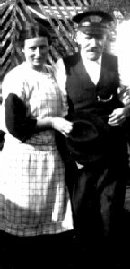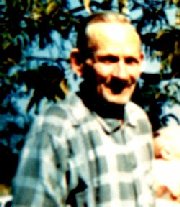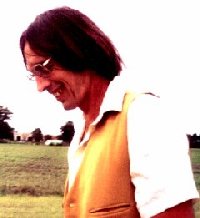(NOTE: If you use the mouse to place the cursor on a photo, it will show a caption for the photo.)
My name in the family tree is William George Sippo. Everywhere else I'm called Bill Sippo. It’s not a common name in Australia. I’ve looked through the telephone directories of all States,
and the only Sippos I’ve found are our children, two cousins, and myself. The first member of the family in Australia was my grandfather Simon Sippo, but his origins weren’t too clear. The family story was that he came from St Petersburg, so it was thought he was Russian, though why a Russian would have a name like Sippo was unexplained.
After I retired from the workforce, I bought a computer and began researching the family. It was eventually discovered that the name is Finnish. From then on, with the help of many very kind and helpful people in Finland, the family origins were tracked down.
 The family lived for many generations in Humaljoki village in the Koivisto parish, part of what is now the lost provinces. My grandfather Simon, or Simo Juhananpoika Sippo, was born at Ilmasti village in the same parish on 15th October 1854 - Juhana at the time was living there on the farm of his wife's family. Records of the Finnish Passport Office St Petersburg show that Juhana had a passport to live in St Petersburg from 1864 to 1869. They also show that Juhana’s father Tahvana Paulinpoika Sippo had been in St Petersburg in 1836. Perhaps Simon also went sometimes with his father. In any event, there was certainly a connection with St Petersburg, probably enough to impress the young teenage Simon with the big city so that he talked about it in his later life in Australia.
The family lived for many generations in Humaljoki village in the Koivisto parish, part of what is now the lost provinces. My grandfather Simon, or Simo Juhananpoika Sippo, was born at Ilmasti village in the same parish on 15th October 1854 - Juhana at the time was living there on the farm of his wife's family. Records of the Finnish Passport Office St Petersburg show that Juhana had a passport to live in St Petersburg from 1864 to 1869. They also show that Juhana’s father Tahvana Paulinpoika Sippo had been in St Petersburg in 1836. Perhaps Simon also went sometimes with his father. In any event, there was certainly a connection with St Petersburg, probably enough to impress the young teenage Simon with the big city so that he talked about it in his later life in Australia.
A book on the history of shipping in Koivisto (S. JUKANEN: Honkalaivat ja halkolastit. Koivisto II. Koiviston pitäjästä ja sen asukkaiden merenkulusta ja laivanrakennuksesta) confirms the family story that Juhana was a ship’s captain. It shows him as skipper of the cutter Pyytävä 1864 - 1868, the cutter Maria 1870, and yawl Maria 1874.
To top of page
Simo’s mother was Lisa Matintytär Ilmasti, the daughter of Beata Paulintytär Hämäläinen. So the branch of the Sippo family in Australia is also related to the extensive Hämäläinen family in Finland.
There was a family story that Simon came to Australia at the age of 19 (say, about 1873) on a ship skippered by his father, and deserted from the ship in the city of Melbourne. However, the Turku Institute of Migration says that he emigrated to Australia in 1881 via London, on the ship Ivanhoe. It is believed that after arrival he worked for a time with the Railways Department, on the construction of a new railway in the Lilydale area, then a wilderness, now the most Northeasterly suburb of Melbourne. It’s not known how long he worked there, but on 30 December 1889 in the Melbourne suburb of Fitzroy, he married widow Olive McMahon (maiden name Warren) who had a two-year-old daughter from her first marriage, her first husband having died the year the child was born.
This child was raised as one of Simon’s family, and they had nine more children, so this was the family:
- Winifred Ellen McMahon, born 1887. Daughter of Simon’s wife by her first marriage. Became a business woman, lived in the Melbourne suburb of Seddon not far from Simon’s house. Died 1946.
- John Stephen Sippo, born 1890. Never married. Worked for Victorian Railways Department. Inherited Simon’s house and lived there. Died 1944.
- Olive Mary Sippo, born 1891. Never married. Lived in Simon’s house, housekeeping for her brother John and others that stayed from time to time. Died 1951.
- Annie Elizabeth Sippo, born 1893. Never married. Became a schoolteacher. Lived in Simon’s house. Died after a short illness in 1933.
- William Leslie Sippo, born 1895. Married and became my father. Discussed later. Died 1973.

- Simon Charles Sippo, born 1897. Never married. Lived sometimes at Simon’s house, sometimes with his brother William, other times as a seasonal worker in various parts of Victoria and New South Wales. Died 1955.
- Francis Joseph Sippo, born 1899. Never married. Mainly worked casually in many parts of Victoria. Retired to Simon’s house after the death of his brother John. Died 1970.
- Prince Frederick Sippo, born 1902. Never married. Lived at Simon’s house. Died suddenly in 1934.
- Alfred Liddle Sippo, born1904. Never married. Mostly lived at the Garfield farm of his brother William, working on the farm, and also working with William on bridge-building contracts. Died about 1974.
- Ernest Abraham Sippo, born 1907. Married and had two children. Discussed later. Died 1969.
To top of page
In 1894 Simon received a permit to occupy a 20-acre block of land in the South Bunyip area some 80 kilometres east of Melbourne, an area later renamed Iona. The land was part of a very large area being opened for settlement following extensive drainage works in a large swamp area. The permit authorised him to occupy the land for three years, following which he would receive a 21-year lease of the land if he had met all the conditions. There must have been large fires
through the region early in 1898 - I have a copy of a large printed form headed "Bush Fire Relief" in which Simon and his wife applied for help to replace fencing and crop seeds which had been destroyed. Then on 28 July 1898 he lodged his application for the proper lease of the land. Early in 1903 Simon became naturalised as an Australian citizen.
 My father, William Leslie Sippo, was born on 14 September 1895. He is generally believed
to have been the first white child born in the Iona area. A school was built at Iona, and all the family children completed their education there - Simon’s nine plus the daughter from his wife’s earlier marriage. They’ve told how they had to swim across the river each day to reach the school, as the bridges weren’t built until later. In fact Simon eventually built many of the bridges in the district, under contract to the local Council.
My father, William Leslie Sippo, was born on 14 September 1895. He is generally believed
to have been the first white child born in the Iona area. A school was built at Iona, and all the family children completed their education there - Simon’s nine plus the daughter from his wife’s earlier marriage. They’ve told how they had to swim across the river each day to reach the school, as the bridges weren’t built until later. In fact Simon eventually built many of the bridges in the district, under contract to the local Council.
I’ve got no proper evidence as to when the family moved out of the Iona area, but it seems to me that about 1920 they moved to Melbourne and bought a house in the suburb of Seddon. This would also have been about the time a twentyone year lease on the block of land in Iona
would have ended, so perhaps they decided to retire to the city rather than renew the lease.
Sometime in the middle 1920s Simon had a stroke. I was born in February 1925, and my memory of him is of a nice old man who could only walk around when his wife held his arm to help, and who couldn’t speak properly. His wife Olive died on 11 April 1929 and he died soon after,
on 30 April 1929. They are buried in the Footscray cemetery. An unexplained point is that an entry on his death certificate, concerning his time in Australia, includes reference to two years in New South Wales. I’ve still found no other mention of this; if true it must have
been right at the start of his time here, as the rest of his time seems to have been in Victoria.
To top of page
My father William Leslie Sippo, usually called Les, married Daisy May Redmond in 1924 at St Saviours Church of England, in the Melbourne suburb of Collingwood. His address on the marriage certificate is shown as Garfield, which is a small town about 5 kilometres from the
Iona land where he had lived with his father. During this early period he had worked with his father on the land, and also worked with him on his bridge-building contracts. He was also one of the leading players in the Iona Australian-rules football team of the time. Les and Daisy were living in Garfield when I was born in 1925, but not too long after that they moved to Melbourne and rented a house not far from where Simon and the rest of the family were living. My first memories start here. One of those early memories is of going to the movie theatres in Footscray, and saying one of them was not as good as the others because it was too noisy. As I later discovered, the noise was because that particular theatre was showing not just movies but the new wonder, "talkies", movies with sound tracks.
In 1931 my sister Olive May Sippo was born, so the family’s needs increased just at the time the worldwide depression was starting to bite hard. There was no work in Melbourne and very little anywhere else, so in 1932 my parents packed up our belongings and we moved back to Garfield, where they bought a small farm. There, my father was able to get a few contracts to build bridges, which produced enough money to supplement the food we could grow on the farm, so we survived the depression well enough.
About 1934 the family had a bit of a shake-up. My father was away working, and one afternoon the rest of us were walking in to the Garfield shopping centre when we saw a large cloud of dust racing down the hill on the other side of the town. We noted that someone was driving very fast. When we reached the town there were many people gathered around, some just tipping the smashed wreck of a truck back on its wheels, others helping the doctor look after two injured men, and someone telling us another man had been killed. Then there was a loud call that a hand could be seen under a pile of cargo from the truck,
and when this was moved my father was found.
It was found that an oil pipe had broken in the hydraulic system of the truck, so that the brakes failed. The truck turned over twice at the foot of the hill, throwing everyone out and bursting into flames. The local newspaper reported "Sippo was also badly cut about, and it was found necessary to have 138 stitches inserted in his many wounds.
The accident cast quite a gloom over the whole district, as all the men were well and favourably known".
Eventually he recovered and things continued as usual and gradually improved as the world depression slowly lifted. In 1963 my mother died suddenly, which was a great blow to my father, who didn’t really recover from the shock and lost the will to live. He died in 1973. My sister had married Raymond Smedley and they lived with my father with their two children. After his death they continued in the house. One of her children is married and has two children of her own.
 I had gone to Papua New Guinea in 1946 and worked for the government there until
1975 when I retired, and we now live in Nowra, NSW. It was a most varied and interesting job, but not one to describe in a paragraph. In 1952 I married Anne Winifred McIntosh and we have four children and four grandchildren, scattered widely throughout Australia.
I had gone to Papua New Guinea in 1946 and worked for the government there until
1975 when I retired, and we now live in Nowra, NSW. It was a most varied and interesting job, but not one to describe in a paragraph. In 1952 I married Anne Winifred McIntosh and we have four children and four grandchildren, scattered widely throughout Australia.
Simon’s youngest son Ernest married Alice Raynor in the mid 1930s. They lived for a number of years on a farm at Rythdale, about 25 kilometres west of Garfield. Then they moved to the Melbourne suburb of Seddon and lived near Simon’s old house where some of the family still lived. Like my father, Ernest was an Australian-rules footballer. He played with Rythdale, and then when in Seddon played for the major league team of Footscray. Ernest and Alice had two children, Judith and Robert. Both of these are married and each has
two children. Judith’s eldest child is married and has a child of her own. Ernest died in 1969 and Alice in 1977.
 The family lived for many generations in Humaljoki village in the Koivisto parish, part of what is now the lost provinces. My grandfather Simon, or Simo Juhananpoika Sippo, was born at Ilmasti village in the same parish on 15th October 1854 - Juhana at the time was living there on the farm of his wife's family. Records of the Finnish Passport Office St Petersburg show that Juhana had a passport to live in St Petersburg from 1864 to 1869. They also show that Juhana’s father Tahvana Paulinpoika Sippo had been in St Petersburg in 1836. Perhaps Simon also went sometimes with his father. In any event, there was certainly a connection with St Petersburg, probably enough to impress the young teenage Simon with the big city so that he talked about it in his later life in Australia.
The family lived for many generations in Humaljoki village in the Koivisto parish, part of what is now the lost provinces. My grandfather Simon, or Simo Juhananpoika Sippo, was born at Ilmasti village in the same parish on 15th October 1854 - Juhana at the time was living there on the farm of his wife's family. Records of the Finnish Passport Office St Petersburg show that Juhana had a passport to live in St Petersburg from 1864 to 1869. They also show that Juhana’s father Tahvana Paulinpoika Sippo had been in St Petersburg in 1836. Perhaps Simon also went sometimes with his father. In any event, there was certainly a connection with St Petersburg, probably enough to impress the young teenage Simon with the big city so that he talked about it in his later life in Australia.
 My father, William Leslie Sippo, was born on 14 September 1895. He is generally believed
to have been the first white child born in the Iona area. A school was built at Iona, and all the family children completed their education there - Simon’s nine plus the daughter from his wife’s earlier marriage. They’ve told how they had to swim across the river each day to reach the school, as the bridges weren’t built until later. In fact Simon eventually built many of the bridges in the district, under contract to the local Council.
My father, William Leslie Sippo, was born on 14 September 1895. He is generally believed
to have been the first white child born in the Iona area. A school was built at Iona, and all the family children completed their education there - Simon’s nine plus the daughter from his wife’s earlier marriage. They’ve told how they had to swim across the river each day to reach the school, as the bridges weren’t built until later. In fact Simon eventually built many of the bridges in the district, under contract to the local Council. I had gone to Papua New Guinea in 1946 and worked for the government there until
1975 when I retired, and we now live in Nowra, NSW. It was a most varied and interesting job, but not one to describe in a paragraph. In 1952 I married Anne Winifred McIntosh and we have four children and four grandchildren, scattered widely throughout Australia.
I had gone to Papua New Guinea in 1946 and worked for the government there until
1975 when I retired, and we now live in Nowra, NSW. It was a most varied and interesting job, but not one to describe in a paragraph. In 1952 I married Anne Winifred McIntosh and we have four children and four grandchildren, scattered widely throughout Australia.